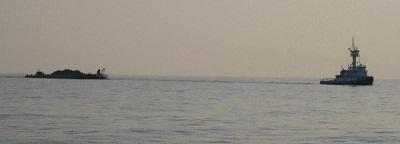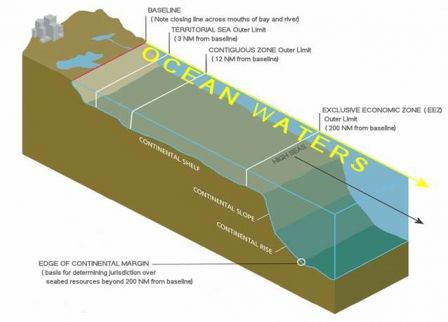Ocean Dumping Permits
The Marine Protection, Research and Sanctuaries Act (MPRSA), also
known as the Ocean Dumping Act, regulates the di sposition of any material in the ocean, unless expressly excluded under the MPRSA. The MPRSA prohibits or restricts (primarily in terms of material type, amount and location) ocean dumping that would adversely affect human health, welfare, amenities, the marine environment, ecological systems or economic potentialities. Section 101 of the MPRSA (33 U.S.C. 1411) generally prohibits the transportation of any material for the purpose of dumping, except as authorized by a permit.
sposition of any material in the ocean, unless expressly excluded under the MPRSA. The MPRSA prohibits or restricts (primarily in terms of material type, amount and location) ocean dumping that would adversely affect human health, welfare, amenities, the marine environment, ecological systems or economic potentialities. Section 101 of the MPRSA (33 U.S.C. 1411) generally prohibits the transportation of any material for the purpose of dumping, except as authorized by a permit.
On this page:
- Who needs an ocean dumping permit?
- What are ocean waters?
- What criteria does EPA use to evaluate applications for ocean dumping permits?
- Who issues ocean dumping permits?
- What types of conditions are included in ocean dumping permits?
- What kinds of ocean dumping permits are issued under the MPRSA?
Who needs an ocean dumping permit?
- Anyone transporting material from the United States for the purpose of dumping it into ocean waters.
- Anyone in a vessel or aircraft registered in the United States or flying the United States flag transporting material from any location for the purpose of dumping it into ocean waters.
- Any United States department, agency or instrumentality transporting material from any location for the purpose of dumping it into ocean waters.
- Any other person dumping material transported from a location outside the United States into the territorial sea of the United States, or into a zone continuous to the territorial sea of the United States, to the extent that it may affect the territorial sea or the territory of the United States.
What are ocean waters?
 Descriptions shown are for purposes of the Marine Protection, Research, and Sanctuaries Act (MPRSA) only. The United States seaward boundaries vary, depending on the legal context, because some statutes (i.e., MPRSA) specify fixed seaward boundaries that are closer to shore than necessary under international law. Illustration does not include international boundaries. Illustration is not to scale. Illustration derived from: “An Ocean Blueprint for the 21st Century, Final Report of the U.S. Commission on Ocean Policy” (Figure P.1, Pg 42).
Descriptions shown are for purposes of the Marine Protection, Research, and Sanctuaries Act (MPRSA) only. The United States seaward boundaries vary, depending on the legal context, because some statutes (i.e., MPRSA) specify fixed seaward boundaries that are closer to shore than necessary under international law. Illustration does not include international boundaries. Illustration is not to scale. Illustration derived from: “An Ocean Blueprint for the 21st Century, Final Report of the U.S. Commission on Ocean Policy” (Figure P.1, Pg 42).
Click on the image to view a larger version.
Ocean waters are the open seas lying seaward of the “baseline” from which the “territorial seas” are measured. Generally speaking, the baseline is the mean lower low water line (ordinary low water mark) along the coast or “closing lines” that are drawn on maps across rivers mouths and openings of bays and that are depicted on official United States Nautical Charts (i.e., National Oceanic and Atmospheric Administration (NOAA) nautical charts for a region). For purposes of the MPRSA, the territorial sea extends seaward to three nautical miles (nm) and the contiguous zone extends seaward from the baseline 12 nm.
What criteria does EPA use to evaluate applications for ocean dumping permits?
The ocean dumping criteria apply to the review and evaluation of all MPRSA permit applications and consider, among other things:
- the need for dumping;
- the environmental impact of the dumping, including the effect of dumping on marine ecosystems, shorelines and beaches;
- the effect of the dumping on esthetic, recreational or economic values;
- the adverse effect of dumping on other uses of the ocean including navigation, scientific study, fishing and resource exploitation activities; and
- land-based alternatives to ocean dumping.
The MPRSA ocean dumping criteria are published at 40 CFR 220-229 (154 pp, 679 K, About PDF).Exit
Who issues ocean dumping permits?
EPA is responsible for issuing permits for ocean dumping of all material except dredged materials. Dredged material refers to material excavated or dredged from the navigable waters of the United States.
The U.S. Army Corps of Engineers (USACE) is the permitting authority for ocean dumping of dredged material. USACE applies EPA’s ocean dumping criteria to determine whether to authorize ocean disposal of dredged material under MPRSA permits (or, in the case of federal projects, to dispose of dredged material in the ocean itself). MPRSA permits for and federal projects involving ocean disposal of dredged material are subject to EPA review and concurrence.
Dumping that occurs in, or affects, ocean waters of a state also may be subject to review for consistency with the enforceable policies of a state’s National Oceanic and Atmospheric Administration (NOAA) t-approved coastal zone program under the Coastal Zone Management Act.
What types of conditions are included in ocean dumping permits?
MPRSA permits designate and include:
- the type of material authorized to be transported for dumping or to be dumped;
- the amount of material authorized to be transported for dumping or to be dumped;
- the location where the transport will be terminated or such dumping will occur;
- such requirements, limitations or conditions as are necessary to assure consistency with any approved site management plan pursuant to MPRSA section 102(c);
- any special provisions for the monitoring and surveillance of the transportation and dumping; and
- any such matters that EPA, or in the case of ocean dumping of dredged material EPA or USACE, as the case may be, deems appropriate.
What kinds of ocean dumping permits are issued under the MPRSA?
Under MPRSA section 103, USACE may issue ocean dumping permits for dredged material and must apply MPRSA requirements directly to federal projects involving ocean disposal of dredged material.
The MPRSA section 102 gives EPA the authority to issue various categories of ocean dumping permits, including general permits, special permits, emergency permits and research permits, for materials other than dredged material.
For more information about permits issued under the MPRSA, please visit the following Web pages:
